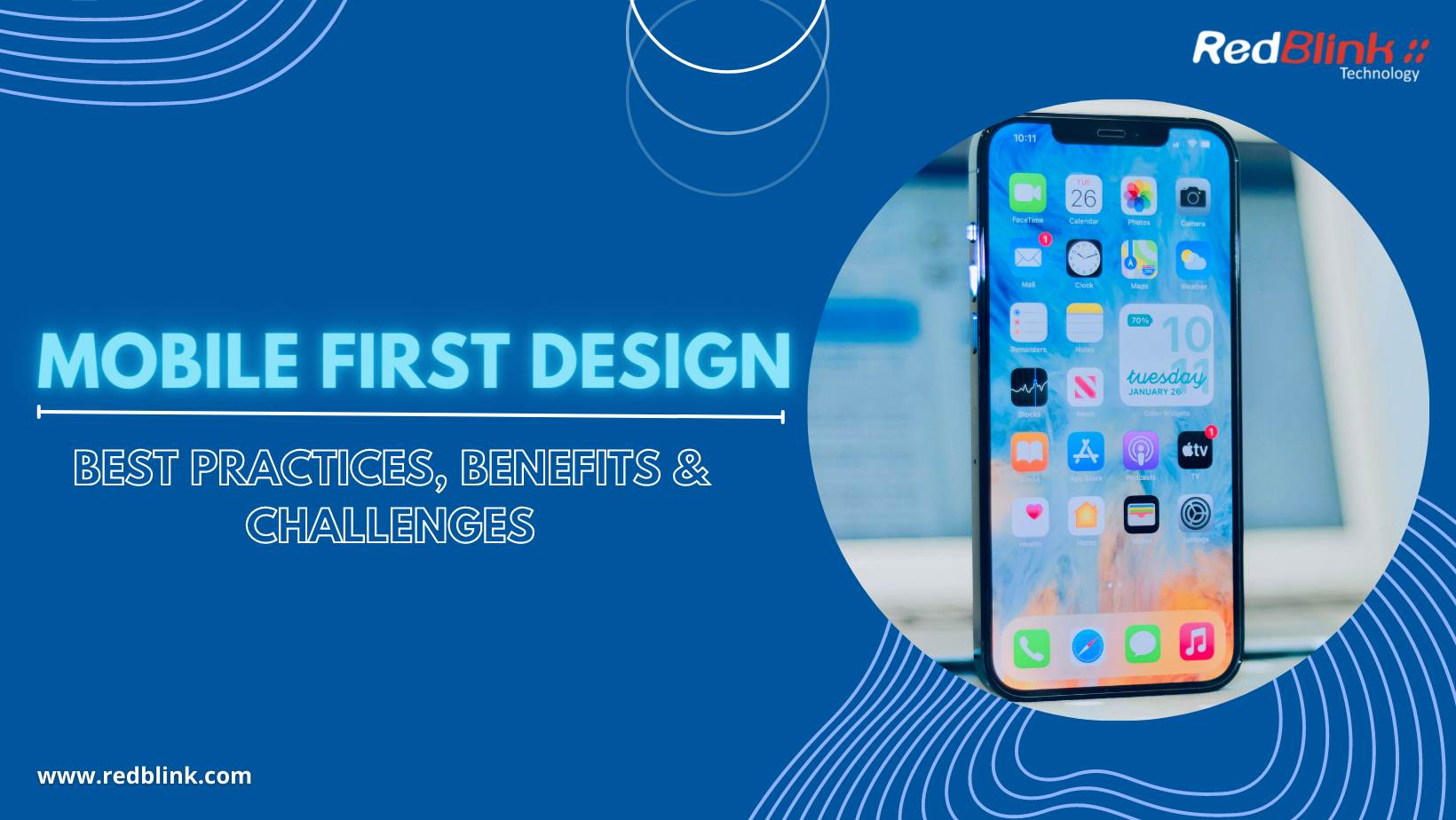Mobile First Design
Mobile-first design is an approach to web development and design prioritizing the needs of mobile users over desktop users. Mobile first approach has become a necessity rather than the choice for a good UX web design due to the release of mobile first indexing update from Google. This update says that Google will give more preference to websites that are mobile friendly.

A mobile first design matches the requirements of all screen sizes such as Android, iOS, and other mobile operating systems.
The sites ranking on the Google SERPs have the following essential design elements
- Good UX UI
- Mobile-Friendly Website / responsive web design
- Simple Navigation and Functional Design
Simply put, Google’s algorithm also prioritizes mobile-friendly websites to improve the search results on mobile, making it important for businesses to adopt the mobile first design to improve their search engine rankings.
Let’s get to know more about the importance of mobile-first design while designing websites.
Contents
What is Mobile-first Design?
Mobile-first design is a design philosophy to create better user experiences by beginning the UX design process for smaller screens.
This mobile website strategy stems from the concept of progressive advancement. To design web pages, a web designer sits down to prototype or sketch a website layout. The web design layout starts with choosing design elements suitable to small screens and then move to bigger screens later. This progressive approach allows designers to minimize UX design mistakes and deliver the right user experience to the right device. Moreover, a responsive design approach is the best strategy for experiencing the good browsing experience.
Also Read: Popup UX Design: Key Factors, Best Practices, Tips in 2024
Starting your product design with smaller screens enforces restrictions like bandwidth, screen size, and limited or no multitasking capabilities. When the platform is expanded to a tablet or PC, you can expand the features. As you gain more screen compatibility, the designing needs like UI UX design and digital marketing become easy.
The Benefits Of Mobile-First Design
As the number of mobile users continues to grow at an unprecedented rate, it is crucial to design for mobile. According to a CNBC report, by 2025, mobile usage is projected to increase by 72.5%. This means that mobile users will outnumber desktop users. Failing to design for mobile will likely result in a suboptimal user experience.
Mobile-first design has several benefits, including:
-
Improved mobile user experience
A mobile-first approach prioritizes the needs of mobile users, ensuring that their experience is optimized for small screens and touch navigation. Responsive and UX designs techniques consider mobile-first strategy.
To know more about UX design, read our blog post: 10 Most Common UI UX Design Mistakes, Examples & Fixes
-
Faster loading times
Mobile-first design involves using smaller, optimized images and code that loads quickly on mobile devices.
-
Better SEO
Google prioritizes mobile-friendly websites in its search results, so a UX design is not only important for mobile apps but also for website designs. Mobile-based SEO can help improve a website’s search engine optimization.
-
Increased conversions
A mobile-friendly design can lead to increased conversions and sales, as more and more people are using their mobile devices to browse the internet and make purchases.
Also Read: Measure User Experience: Know When to Update Your UX/UI
-
Cost-effective
Developing for mobile-first is more cost-effective in the long run as the same design and code can be used for desktops and other devices.
-
Future-proofing:
As mobile usage continues to grow, a mobile-friendly design will ensure an increasing website traffic. The search engine ranking and ROI will definitely improve over time.
10 Best Practices For Mobile-First Design in 2024
1. Keep it simple
Simplicity is key when it comes to mobile-first design. Avoid cluttering the screen with too much information or too many elements.
2. Prioritize content
The most important content should be in the home page or easily trackable. We all know content is the key. A mobile friendly website has crisp, short and informative content. Use of optimization techniques using AI tools is the latest way to develop content for the mobile first websites.
3. Optimize for touch
Make sure buttons and other interactive elements are large enough to be easily tapped with a finger. UI has a greater importance when considering the design elements.
4. Use responsive design
A responsive design ensures a good website looks. Apart from screen friendly designs, a simple to navigate and optimized site is the need to improve customer engagement.
5. Optimize for speed
Mobile users expect fast load times, so make sure to optimize images and other elements for faster loading. Also, sometimes focusing too much on design does not mean that you neglect the coding and optimization of content. Design, coding and content are the three ingredients to create a ranking website.
6. Use mobile-friendly navigation
Navigation should be simple, intuitive, and easy to use on a small screen.
7. Test on different devices
Test your design on a variety of devices, including smartphones and tablets, to ensure it looks and works well on all of them.
Also Read: Website Refresh vs Website Redesign : Comparison & Benefits
8. Use Finger-friendly typography
Make sure your text is easy to read on a small screen by using a font that is large enough to be read easily and with enough space between lines.
9. Use white space
The use of white space can help to create a sense of openness and can make it easier to focus on the most important elements of your design.
10. Consider device capabilities
Some mobile devices have specific capabilities such as touch-screen, accelerometer, and others, and it is important to consider how to make the best use of these capabilities in the design.
Challenges of Mobile-First Design in 2024
Mobile first web design is the approach of designing responsive designs for smaller screens, desktops and other larger screens. Some of the challenges and considerations of mobile-first design include:
-
Keeping up with new technologies and devices
With the constant evolution of mobile technology, designers must stay up-to-date with new devices and screen sizes to ensure that their designs are optimized for a wide range of devices.
-
Balancing mobile first design with other priorities
Mobile-first design can often conflict with other design priorities, such as aesthetics or functionality. Designers must find a balance between designing for mobile and meeting other project requirements.
-
Ensuring accessibility for all users
Mobile experience can often result in interface designs that are not accessible to users with disabilities or older devices. Designers need to consider UX design to ensure accessibility needs of web/mobile apps.
-
Optimizing performance
Most mobile experiences have limited resources and capabilities. UX designers must consider website optimization to improve the website performance to ensure faster loading speed on mobile devices.
-
Adjusting for different screen sizes
Mobile sites come in different screen sizes, and designers must consider how to adjust the layout and design to ensure that it looks good and works well on different screen sizes.
Final Thoughts
Mobile first design is one of the essential design elements in today’s digital landscape. The benefits of mobile-first design include improved user experience, better accessibility, and enhanced search engine optimization.
To implement the mobile-first design, designers should focus on designing for the smallest screen first, prioritize content, and make sure that the design is responsive and adapts to different screen sizes.
It is also important for designers to stay current and adapt to new technologies and trends to ensure that their designs are optimized for the latest devices and technologies.
Considering a web design and development company adopting a mobile first strategy will be a wise step for your new web designing project.
To do so, get in touch with a top-rated agency. You may consult RedBlink for developing the best design that goes with the requirements catering to the business needs as well.

Director of Digital Marketing | NLP Entity SEO Specialist | Data Scientist | Growth Ninja
With more than 15 years of experience, Loveneet Singh is a seasoned digital marketing director, NLP entity SEO specialist, and data scientist. With a passion for all things Google, WordPress, SEO services, web development, and digital marketing, he brings a wealth of knowledge and expertise to every project. Loveneet’s commitment to creating people-first content that aligns with Google’s guidelines ensures that his articles provide a satisfying experience for readers. Stay updated with his insights and strategies to boost your online presence.
